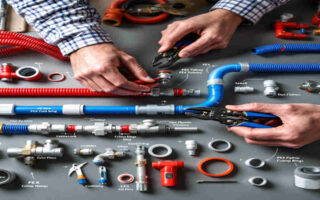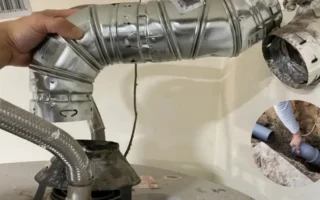Venting is a critical aspect of home plumbing systems that often goes unnoticed until there’s a problem. Proper venting ensures the efficient functioning of your plumbing and plays a crucial role in maintaining health and safety within your home.
Importance of Proper Venting
Venting allows air to enter the plumbing system, which helps to maintain proper pressure and facilitates smooth drainage. A well-vented plumbing system prevents sewer gases from entering your living space, ensuring your home remains safe and odour-free. Additionally, proper venting can enhance the overall efficiency of your plumbing, reducing the likelihood of clogs and backups.
Understanding Plumbing Vent Systems
What Is Plumbing Venting?
Plumbing venting allows air to flow into the plumbing system to maintain a balance of pressure. The vent pipes connect to the drainage system, allowing air to enter and preventing the formation of a vacuum that could hinder drainage.
These vents serve several functions:
- Preventing sewer gas entry: They allow harmful gases to escape outside.
- Facilitating drainage: They ensure water flows smoothly through the pipes by equalising pressure.
Why Proper Venting Is Essential
Proper venting is critical for several reasons:
- Preventing sewer gas entry: Without adequate venting, toxic gases can seep into your home, posing health risks.
- Ensuring smooth drainage: Venting mitigates pressure imbalances leading to slow drainage or backups.
- Avoiding clogs: A well-vented system minimises the chances of clogs and other plumbing issues.
Common Signs of Poor Venting
How can you tell if your plumbing system is not vented properly? Look for these signs:
- Gurgling drains: This often indicates air is trapped in the pipes.
- Slow drainage: Water takes longer than usual to drain from sinks or tubs.
- Unpleasant odours: Foul smells may suggest sewer gases are escaping into your home.
Key Components of a Home Plumbing Vent System
Main Vent Stack
The main vent stack is the primary vertical pipe extending from the drainage system to the roof. Its role is to allow air to enter and exit the plumbing system. Typically, it is located near the centre of the home to serve all plumbing fixtures efficiently.
You may also read (snake your toilet at home)
Branch Vents and Individual Fixture Vents
Branch vents connect individual fixtures to the main stack. Each fixture, such as sinks, toilets, and tubs, has a vent connecting to the main vent stack. This design ensures air flow freely from each fixture, maintaining proper pressure throughout the system.
Cleanouts and Access Points
Cleanouts are access points throughout the plumbing system, allowing easy maintenance and rodding. They are crucial for clearing blockages and ensuring the plumbing system remains functional.
ComponentDescriptionTypical Location
Main Vent Stack Primary vertical pipe Centre of the home
Branch Vents connect fixtures to the main stack near individual fixtures
Cleanouts, Access points for maintenance, Various locations
Plumbing Venting Methods Explained
Individual Venting
Individual venting involves installing a separate vent for each fixture. This method is straightforward, ensuring each fixture has adequate ventilation. However, it can be more expensive and space-consuming due to the number of pipes required.
Common Venting
Standard venting is used when two fixtures are close together, allowing them to share a vent. This method is cost-effective and saves space, but it requires careful planning to ensure proper airflow.
Wet Venting
Wet venting allows certain fixtures to share a vent if they are correctly connected. This method has specific code requirements, so checking local regulations is vital. Suitable fixtures include sinks and toilets that are located close together.
Circuit Venting
Circuit venting enables multiple fixtures to draw air from one vent. This method can accommodate up to eight fixtures per branch, making it efficient for larger systems. Proper sizing and installation are crucial; larger stacks may need relief vents.
Alternative Venting Options
When traditional venting methods are impractical, consider alternative options like:
- Air Admittance Valves (AAVS): These one-way valves allow air while preventing sewer gases from escaping.
- Island fixture vents: Designed for island sinks, they allow proper venting without running pipes through the ceiling.
How to Properly Vent Home Plumbing: Step-by-Step Guide
Review Local Plumbing Codes
Before starting any plumbing project, reviewing local plumbing codes is crucial. Compliance with these regulations ensures safety and legality. You can usually find code information through your local building department or online resources.
Create a Plumbing Venting Plan
Next, create a plumbing venting plan. This should include:
- Mapping out all fixtures and their respective vent routes.
- Considering future expansions or changes to your plumbing system.
Start at the Most Upstream Fixture
Begin venting at the most upstream fixture. This order is essential for adequate venting, allowing air to flow freely through the system. Typical fixture order usually starts with sinks, followed by toilets and tubs.
Install the Vent Pipe
When installing the vent pipe, consider the following:
- Choosing the right materials: Use PVC or ABS pipes for durability.
- Correct sizing and slope: Ensure the pipe has a slight slope to facilitate airflow.
- Routing through walls, attics, and roofs: Plan the path carefully to avoid obstructions.
Connect to Main Stack or Roof Vent
Properly connect the vent pipe to the main stack or roof vent. Use secure fittings and ensure there are no gaps that could allow air to escape. A clear path for air is vital for maintaining proper pressure.
Continue Venting for All Fixtures
Make sure to vent every fixture in your plumbing system. Consider using branch vents for complex layouts to ensure all fixtures have adequate airflow.
Consider Alternative Methods If Needed
If traditional venting is impractical, consider using AAVS or horizontal vents. These alternatives can help maintain proper pressure without extensive piping.
Test the Venting System
Once installed, it’s essential to test the venting system. Check for proper water flow and inspect for leaks or blockages. This step ensures that the system is functioning as intended.
When to Call a Professional Plumber
If you encounter complex systems or persistent issues, don’t hesitate to call a professional plumber. They have the expertise to diagnose and resolve any venting problems effectively.
Best Practices for Venting Home Plumbing
Sizing Vent Pipes Correctly
Ensure you size your vent pipes correctly based on local codes. Common mistakes include using too small pipes, which can lead to inadequate ventilation.
Maintaining Proper Slope and Distance
Maintaining the proper slope and distance is crucial in preventing water traps in vents. Follow the maximum allowable distances to ensure efficient drainage.
Preventing Common Venting Problems
To avoid common venting problems, consider the following:
- Blockages: Regularly inspect and clean vents to prevent clogs.
- Freezing in cold climates: Insulate vent pipes in freezing areas to avoid damage.
- Animal or debris entry: Install screens on vent openings to keep out pests.
Troubleshooting and Maintenance
Diagnosing Venting Issues
If you suspect venting issues, start by diagnosing the symptoms. Common indicators include gurgling sounds or slow drainage. Perform DIY checks, but consult a professional for complex assessments.
Cleaning and Maintaining Vents
To keep your vents in good shape, regularly clean and maintain them. Safely clear any blockages using appropriate tools, and schedule professional maintenance as needed to ensure longevity.
You may also read (home plumbing systems)




